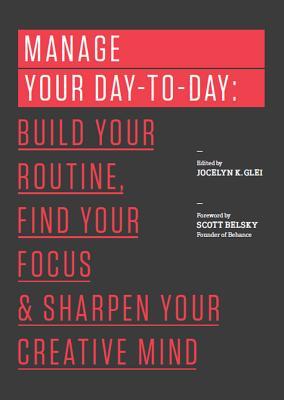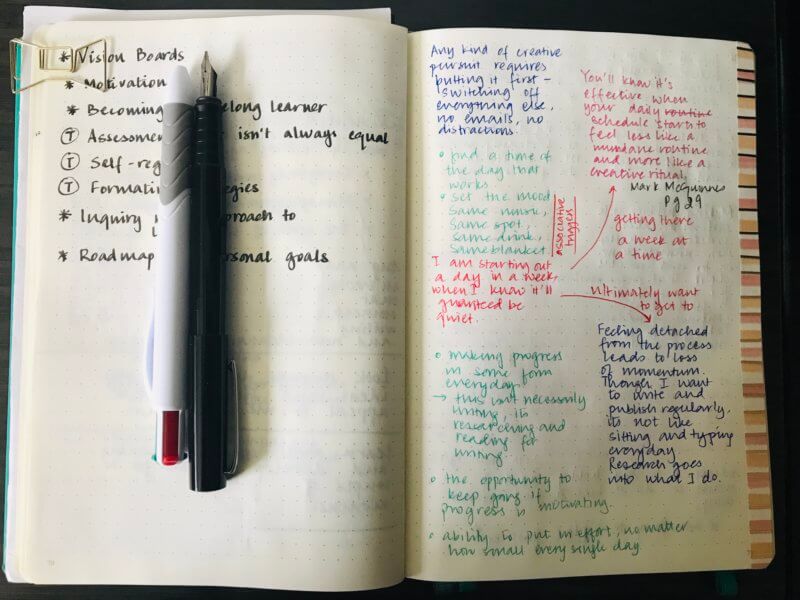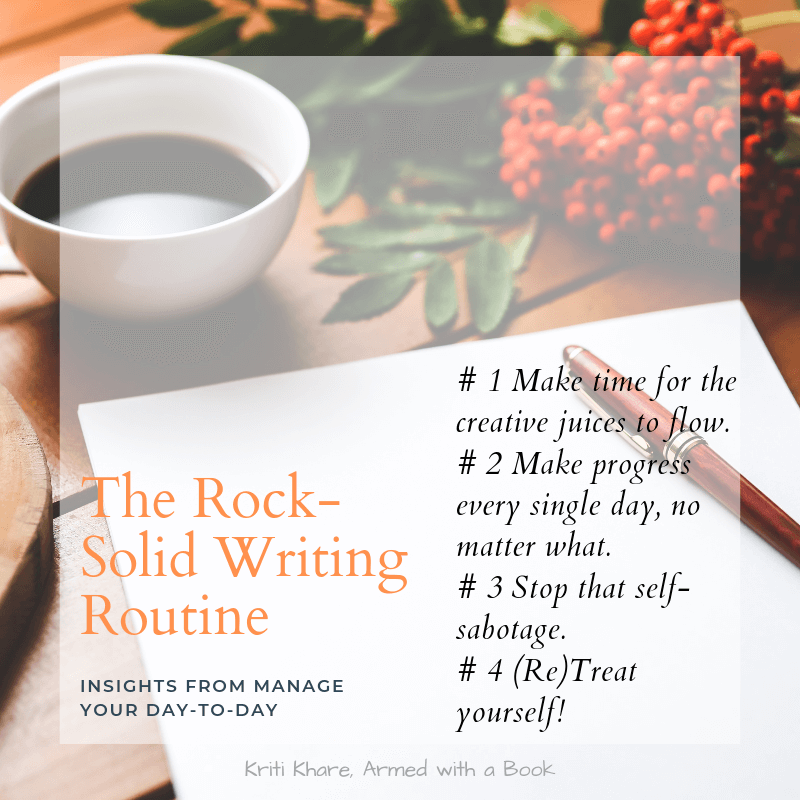I write for pleasure and keeping a record of the things that I have learned from books, experiences and more. Usually, I have an idea I want to elaborate on, I research it and then write about it. However, this is heavily dependent on finding ideas to write about, and having too many of them can be overwhelming. There are many a lists in my journals for ideas I want to work on and just haven’t gotten to. A writing routine helps me pursue this goal of learning, letting me know I am making some progress everyday.

This month, I started my journey of re-cultivating the routines that I had not been able to give time to the past couple months. Like I mentioned in my article on getting back into writing, I felt that the best way to build a writing routine was for me to read about writing. To fuel the fire of reading that I feel inside, and use it to strengthen the written words that come out of my head, is an exciting endeavour.

When I think about creating new routines, I think about time management. Writing is a creative art. It is impossible to want to create a writing routine without referring to people who have succeeded in being productive. I picked up Manage your day-to-day: Build your routine, find your focus & sharpen your creative mind to learn about routines and finding time for creativity. It is a collection of insights from leading creative minds, such as Cal Newport, Dan Ariely and Seth Godin.
I am absolutely loving reading this book, not just for what it offers but also finding joy in commenting, highlighting and adapting it to my own experiences. I am excited to share the ideas I am learning, and hope that you find some inspiration for your own writing routine this way.
What got me into this book
In last couple months, there have been a lot of changes in my routine. I have gone from being a university student, taking courses four days a week and working part-time, to being a full-time teacher in the final part of my teaching degree, to, now, a full-time data analyst. This time, I hope to solidify the habits and build a routine such that the next change doesn’t mean starting from scratch again.
This book is about the problems we face in our everyday lives, surrounded by technology, the things we want to accomplish and how we go about prioritizing these things. Further, it also talks about the ways in which we can adapt when there are huge changes in our lives, keeping the habits that we want to keep at the heart of what we do. By taking a look at the way some creative minds approach this, the book is a compilation of strategies that are now at my fingertips to try.
Manage your day-to-day is about creativity and making time for the creative work. For many of the people interviewed in this book, their creative work is their profession. Someone is a painter, another person is a writer, or a journalist… I am none of those things and what I am looking for is ways to keep the habits I want to keep. I am trying to dedicate some time in the course of my day to pursue my creative endeavours.
Our individual practices ultimately determine what we do and how well we do it. Specifically, it is our routine (and lack there of), our capacity to work proactivity, rather than reactively, and our ability to systematically optimize our work habits over time that determine our ability to make ideas happen.
Scott Belsky, Founder of Behance and author of Make Ideas Happen, Pg 17 of Manage your day-to-day
Pursuing Writing
The following are the insights and reflections from the first part of Manage your day-to-day, building a rock-solid routine.
# 1 Make time for the creative juices to flow.
Any kind of creative pursuit requires putting it first – switching off everything else, such as emails, that would cause a distraction. Look through your daily routine and find a time that works well for writing. The same music, place to write, and a drink act as associative triggers to get into the headspace of writing.
You’ll know it’s effective when your daily schedule starts to feel less like a mundane routine and more like a creative ritual.
Mark McGuinnes, Pg 29 of Manage your day-to-day
I do not have a daily time set for writing yet, however, I keep my Friday evenings dedicated to working on blog posts, such as this one. I hope that eventually I will be able to find other pockets during the week when I can write. Starting small and celebrating the little successes is a way to keep going.
# 2 Make progress every single day, no matter what.
Once I stop doing something, it is natural to feel detached from the process. Thoughts like “Will I ever get back to writing? Which idea should I pursue out of all of these? I need to research before I write, but I just want to write right now?!” cloud my mind too sometimes and, with procrastination, I loose momentum. Recognizing that the writing routine isn’t solely based on writing was a big revelation for me. Research and reading plays a key role in the type of writing I do. Hence, making some progress towards writing everyday in fulfilling the tasks that contribute to it is necessary.
Putting in effort towards the writing goal, every single day, no matter how small it may be, is motivating. Like I mentioned earlier, I keep Friday evenings for writing. However, the rest of the week, I read and make notes, getting ready for when I get to the writing itself. New questions arise as I write and I often have to go back to researching to answer them for clarification.

This closely relates to this quote from Seth Godin about pursing something everyday, even when one does not feel inspired to.
The notion that I do my work here, now, like this, even when I do not feel like it and especially when I do not feel like it, is very important. Because lots and lots of people are creative when they feel like it but you are only going to become a professional if you do it when you don’t feel like it. And that emotional waiver is why this is your work and not your hobby.
Seth Godin, Pg 42 of Manage your day-to-day
This really got me thinking about being a professional while pursing my hobby. That takes practice and effort. This is true when cultivating a writing routine, and any other habit for that matter, because no matter how I feel inside, I have to do it. I can’t not show up if I truly care about this.
# 3 Stop that self-sabotage.
There is a voice in my head that doubts me. It tells me that I am not good enough and it is purely a self-sabotaging mechanism. It gives me excuses to not pursue what I want to write because I am thinking “Who am I? Why would anyone read this?” We know that the world is quick to judge, and so is the voice that resides in our heads. I am sure that at some point of time, you have heard yours too.
It’s hard to build an identity that one feels is incomplete without something else. But as someone who wishes to pursue creative work, I have to do it anyway.
Another book that offers insight about creating content that matters, not just to the self, but also to the readers and fears in sharing content online is Content Rules: How to Create Killer Blogs, Podcasts, Videos, Ebooks, Webinars (and More) That Engage Customers and Ignite Your Business. It is about
The more valuable the information you can give to others, the more you will become viewed as an expert and therefore gain their trust.
From Content Rules, Handley & Chapman (2012), Chapter 2.
I blog for pleasure to a target audience and this statement brings relief to me. I am capable of, and have always put in, thorough research and ideas in the articles that I write. The books and articles I read are from a curiosity perspective – here’s my question, how can you help me? – and then I present my answers, hoping that the reader can take advantage of the work I put in.
The effort that you put in your writing is combating the self-sabotage. Don’t give up!
# 4 (Re)Treat yourself!
Retreats and bootcamps are good ways to do some no-pressure creative work in dedicated amount of time. I have not yet tried to have a timed challenge for writing or a full day of working on just one thing, but I can imagine the surge of energy and focus that this would bring. I will surely try one and share my thoughts in the future.
Recently, I have also considered incorporating short writing exercises which have nothing to do with my blog posts, to do some creative writing everyday.
If you are in a situation in which I can help you, or you think would be fun for a retreat idea, tell me and I will see what I can do!
What’s next?
There are pearls of wisdom scattered everywhere and ultimately it is up to us to examine them and make them our own. Every person’s experiences are different and their goals likely differ as well. For building a writing routine for publishing on this blog, inspiration will be found in reading about writing and also in settings and mindsets that let creative juices flow.

More about writing next time! Until then, please do share your thoughts with me on Twitter. Feel free to give me a shout to talk about writing and reading. 🙂
What is the one part of your writing routine that you absolutely love? Which is one part that you think you need to work on?

Be First to Comment